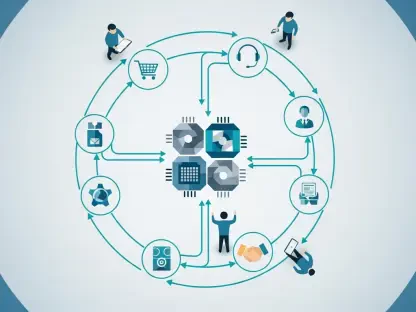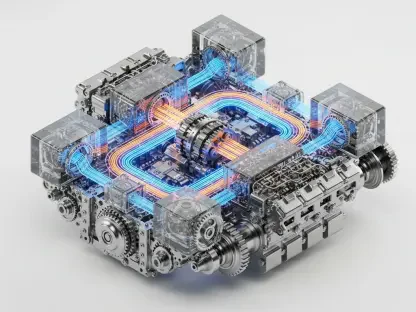As we dive into the evolving landscape of cybersecurity, I’m thrilled to sit down with Marco Gaietti, a veteran in the field with decades of experience in management consulting and a deep understanding of business management. Marco has spent years helping organizations navigate complex challenges in strategic operations and customer relations, and today, we’re focusing on a critical issue: the hidden costs of cybersecurity and the innovative solutions reshaping how companies protect themselves. Our conversation explores the burdens of outdated systems, the financial impact of data breaches, and the transformative potential of modern network architectures. Marco also sheds light on how businesses can gain a competitive edge by rethinking their approach to security.
Can you walk us through the concept of a ‘cybersecurity tax’ that companies are unknowingly paying?
Absolutely, Richard. The ‘cybersecurity tax’ isn’t something you’ll find explicitly listed in a company’s financial statements, but it’s a very real cost embedded in multiple areas. It shows up in skyrocketing insurance premiums, often rising 15-25% each year due to increasing breach risks. It’s in the constant need to refresh hardware every few years, the per-user licensing fees that pile up with every new employee, and the significant time and resources IT teams spend managing clunky, incompatible VPN systems. Beyond that, there’s the looming threat of a data breach, which averages $4.4 million per incident. These costs—whether it’s business downtime, customer support after a breach, or reputational damage—add up to a hidden burden that drags down a company’s efficiency and profitability.
How do legacy VPN systems play a role in driving up this cybersecurity tax?
Legacy VPNs are a big contributor because they were built for a different era—think late 1990s, when a handful of employees needed remote access from home. Today’s reality is far more complex with employees, contractors, and data spread across multiple continents and cloud platforms. VPNs create a single entry point to an entire network, which is a massive vulnerability. Operationally, they’re a nightmare—different departments often use different VPN solutions, hardware needs frequent replacement, and IT staff are stuck managing access instead of focusing on innovation. This setup not only racks up costs through licensing and maintenance but also increases risk, making companies more likely to face a costly breach.
Speaking of breaches, can you elaborate on why the $4.4 million average cost is such a critical figure for businesses to grasp?
That $4.4 million figure is a wake-up call. It represents the average financial hit a company takes when a breach occurs, and it’s not just about paying fines or legal fees. The biggest drivers are business disruption—think payroll systems freezing or call centers going offline—and the long-term damage to customer trust, which alone can cost $1.47 million on average. It takes years to rebuild that trust, and during that time, you’re losing business. For some companies, especially after high-profile incidents, the costs can skyrocket into the hundreds of millions or even billions. Understanding this number pushes leaders to prioritize security not just as a technical issue, but as a core financial and strategic concern.
Let’s shift gears to solutions. How do software-defined mesh networks differ from traditional VPNs in tackling these challenges?
Mesh networks are a game-changer because they fundamentally rethink how connections are made. Unlike VPNs, which funnel all traffic through a central gateway—creating a single point of failure—mesh networks establish direct, encrypted peer-to-peer connections between devices. Each device, whether it’s a laptop or a server, has a unique cryptographic ID, and data flows directly between them without a vulnerable chokepoint. This setup cuts down on operational overhead since there’s no need for constant hardware upgrades or complex licensing. More importantly, it shrinks the attack surface, reducing both the risk of breaches and the associated costs of the cybersecurity tax.
I understand platforms like ZeroTier are leading this shift. Can you explain how their technology works to secure connections?
Sure, ZeroTier is a great example of this new architecture. Their platform works by installing a lightweight agent on each device—laptops, servers, even IoT sensors. Every device gets a unique cryptographic identity, and connections are made directly between devices with end-to-end encryption. A central controller handles authentication, but the actual data transfer bypasses any single hub. This means if one device is compromised, the damage is contained; there’s no backdoor to the entire network. It’s a scalable, software-driven approach that lets companies add users or locations in minutes without the heavy lifting of traditional VPN setups.
The Cloudflare outage in June 2025 was a significant event. How did it highlight the vulnerabilities of traditional systems?
The Cloudflare outage was a stark reminder of the risks tied to centralized systems. When it went down, a huge chunk of the internet ground to a halt because so many companies relied on that single point of failure. Organizations still using traditional VPNs were hit hard, facing downtime and operational chaos. In contrast, companies with mesh networks kept running smoothly since their architecture doesn’t depend on a central hub. This event underscored a critical lesson: relying on a single gateway or provider isn’t just inconvenient—it’s a massive liability that can cripple your business when things go wrong.
What kind of competitive advantage do companies gain by adopting mesh networks over legacy systems?
Companies that switch to mesh networks get a significant edge because they’re no longer weighed down by the cybersecurity tax. They save on hardware costs, licensing fees, and the manpower needed to manage outdated systems. Those savings can be reinvested into lowering prices, improving products, or boosting profit margins. They can also scale faster—adding new users or locations doesn’t mean shelling out for more licenses or hardware. Take a company like Metropolis, which scaled from thousands to 100,000 devices without the burden of VPN costs. That kind of agility lets them outmaneuver competitors still stuck paying the tax.
I’ve heard insurance premiums are rising for companies using legacy VPNs. Can you explain why that’s happening?
It’s all about risk assessment. Insurance underwriters look at breach statistics, and the data is clear: companies using legacy VPNs are far more likely to get hit. With 48% of these organizations already experiencing a breach, insurers are hiking premiums by 15-25% annually to cover the potential payouts. High-profile incidents—like attacks on critical infrastructure or school systems going offline for days—only reinforce this trend. On the flip side, companies using zero-trust mesh networks often get better rates because their smaller attack surface translates to lower risk in the eyes of actuaries.
Looking ahead, what’s your forecast for the future of cybersecurity architectures and their impact on business competitiveness?
I believe we’re at a tipping point. The shift to mesh networks and zero-trust architectures isn’t just a trend—it’s becoming a necessity. As attackers get more sophisticated, especially with AI-driven tools, the attack surface will keep growing, and the cybersecurity tax will only get heavier for those clinging to outdated systems. Companies that adapt now will not only save on costs but also position themselves to outpace competitors who are slower to change. Over the next few years, I expect to see a widening gap between businesses that embrace decentralized, scalable security solutions and those stuck paying the price—both financially and reputationally—for sticking with the old ways.









